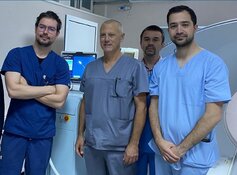TICKERS: ARTC, CAH, CFN, COV, MDT, RMD, STJ
Know Your Medtech Growth Drivers: Joanne Wuensch
Interview
Source: George S. Mack of The Life Sciences Report (3/8/12)
 Medical technology has been stalled in a quagmire of regulation, lowered usage and a more tight-fisted health insurance environment, but Analyst and Managing Director Joanne Wuensch of BMO Capital Markets has identified a few ground-breaking technologies that will drive increasing cash flows in particular companies. In this exclusive interview with The Life Sciences Report, Wuensch delivers the names that will provide essential diversification while they return growth for investors.
Medical technology has been stalled in a quagmire of regulation, lowered usage and a more tight-fisted health insurance environment, but Analyst and Managing Director Joanne Wuensch of BMO Capital Markets has identified a few ground-breaking technologies that will drive increasing cash flows in particular companies. In this exclusive interview with The Life Sciences Report, Wuensch delivers the names that will provide essential diversification while they return growth for investors.
Joanne Wuensch: I think that the group was generally oversold in Q411. Multiples were meaningfully compressed. There was some positive commentary about increased or improving utilization from management at Johnson & Johnson (JNJ:NYSE) on its Q4 call, and from one of the lab companies. It then became sort of a self-fulfilling prophecy whereby depressed stocks reacted and we saw a lot of short covering and a lot of money chasing money. So, we had some very nice price performance in the first eight weeks of the year.
TLSR: So, if medtech is not in a secular uptrend, is this a response to an improving economy?
JW: I think that in many ways the fundamentals are no different today than they were in November. The only thing that has changed is that multiples have become a little bit more normalized and not as depressed. And, as we look at 2012 guidance, a lot of these companies are not assuming a recovery in the second half of the year, which means that estimates are largely achievable for 2012. And that's a relief.
TLSR: You've written rather extensively about more rigorous U.S. Food and Drug Administration (FDA) regulation around medical device development. It has slowed approvals. How significant is this issue?
JW: Well, it's significant because this industry is driven by technology innovation. So, whether you slow down innovation by slowing down approvals or by increasing hurdles required to bring new technology to market, it is more difficult. We are seeing the need for clinical data for 510(k) premarket notifications that were previously accomplished without clinical studies. [Note: Under the 510(k) process of the Federal Food, Drug and Cosmetic Act, if a device is substantially equivalent in safety and its activity or effectiveness, clinical trials are not required]. Sometimes companies run a clinical trial according to specifications from the FDA, and then the FDA sort of sits on the approval process until further notice. We have also seen increased need for economic data from the FDA.
TLSR: How much of this is attributable to increasing complexity in the medtech field?
JW: Some of it is increasing complexity. Some of it has to do with some very high profile problems, such as concerns about metal-on-metal hips, things like that. A new brand of hips was approved by FDA with limited clinical data, and it was a little bit of a black eye on the FDA.
TLSR: What are the other headwind issues you are seeing?
JW: Well, the most basic one is decreased utilization, and that is somewhat driven by the economy. Also, the delivery of healthcare has changed over the last 24 months with the advent of higher co-payments and annual deductibles. Overall, price pressure is higher. Hospitals are more conscious of cost. Administrators have even changed the way products are stocked to save money. Physicians who used to be independent are now working for hospitals, who are managing their expenses. Also, payers are requiring more clinical data to reimburse for a product, and patients have to pay a higher percentage of the surgical and product cost. All of these things have changed healthcare.
TLSR: I can't help but wonder if all of this additional FDA diligence going into development might help when going to Centers for Medicare & Medicaid Services (CMS) to request approval for reimbursement?
JW: In theory, if you have more economic data, it would help when going to CMS for reimbursement.
TLSR: Are these extended approval times driving medtech companies to sell products in emerging and international markets?
JW: Sadly, yes. There's a push for product sales outside the United States because you don't have to go through the FDA hoops, and you don't have to go through the CMS gauntlet. There is also a push into emerging markets because they are largely untapped. It used to be that a company would get a product approved first in Europe, then here in the U.S. and then in Japan. There was zero discussion of emerging markets. The amount of time between approvals from one region to another was one year, maybe two years, but not an extreme period. Now you have products, like transcatheter heart valves (TCHV), that are approved in Europe four years before they're approved in the United States. And, then there's another 18-month, maybe 24-month gap before it is approved in Japan. That's for a high technology product. Now, even for a lower technology product, companies are talking about emerging markets on every single conference call. Going into emerging markets may mean opening a manufacturing facility in China. It may mean increasing your selling, general and administrative expense (SG&A) or redirecting your SG&A to hire feet on the street in those markets. Or in a more subtle or direct way, a company might create a product that is particularly attuned to the emerging markets.
TLSR: Can those data from markets outside the U.S. be used at the FDA?
JW: Well, can they be submitted? By all means submit it. How much the FDA uses that to come to a conclusion on approvability is still, in my opinion, in question. If you run a U.S. clinical trial and you have data from outside the U.S., I don't know if it matters a hill of beans versus a U.S.-run clinical trial and making a decision toward approvability.
TLSR: Does dramatic innovation exist in medtech now?
JW: It does. I would say that TCHVs are a dramatic innovation. I would argue that renal denervation is dramatic innovation. Also, patent foramen ovale (PFO) closure type devices, abdominal aortic aneurysm (AAA) devices and neurovascular products still hold a wide-open opportunity. So, I think there is dramatic innovation. There's less of it, but it still exists.
TLSR: What about cardiac rhythm management (CRM), implantable cardioverter defibrillators (ICDs) and coronary artery stents? Would they figure into an aging baby boomer investment theory?
JW: They do figure into an aging baby boomer theory as well as hips and knees obviously.
TLSR: Are you bullish on the cardiovascular segment?
JW: I'm not bullish on ICDs and stents. I'm largely favoring some of the diversified names. I am bullish on two cardiology companies, Medtronic Inc. (MDT:NYSE) and St. Jude Medical Inc. (STJ:NYSE), but for different reasons. I have them both rated Outperform. Medtronic is trading at a discount to the group's 12–13 times multiple. Medtronic has had its problems, particularly in spine, but it's giving a nice dividend of almost 3%. And, I suspect the relatively new CEO Omar Ishrak, who came from GE Healthcare Systems, a unit of the General Electric Company (GE:NYSE), will start to do some company portfolio management, and in the process we anticipate that the gap in the multiple differential will close.
TLSR: You had mentioned AAA as a growing technology. Medtronic is in AAA.
JW: It is absolutely. It has some other higher technology pockets, renal denervation and TCHVs, and the company just launched a new drug-eluting stent in the U.S. But there are some larger portions of its business, such as ICD and particularly its spine franchises, which have been declining. ICD has been bumping along the bottom.
TLSR: These areas you just mentioned are catalysts for Medtronic, right?
JW: Correct.
TLSR: Do you expect market-moving information this year?
JW: Well, the company hasn't had an analyst meeting in almost two years, but as I look out over the next 12 months, Medtronic will have its first analyst meeting under the new CEO in June of this year. As he starts to unveil plans for how he's going to make his mark at the company, the stock should respond in kind.
TLSR: You said you are bullish on St. Jude Medical.
JW: Yes, this is a company that is still heavily devoted to the CRM market. But also similar to Medtronic, it is investing in the higher growth areas, such as atrial fibrillation, TCHVs, renal denervation and PFO closure devices. It has also been steadily taking share in the ICD market, and it received FDA approval in Q411 for a new quadripolar pacing lead, which allowed it to take some market share in Europe. There is a similar expectation here in the U.S.
TLSR: Can we talk about your other Outperform-rated companies?
JW: Sure, let's take them individually. Covidien Ltd. (COV:NYSE) was spun out from Tyco Healthcare Group LP about four years ago. It has done a very good job of rearranging its architecture. It has sold off non-core businesses and actively invested in higher-growth business, and in the process it has expanded operating margins and generated a heck of a lot of cash. It's about to go through another transformation with the sale of its pharmaceutical franchise, and I expect that to happen in H113. It should end up as a company dedicated to medical devices, including some hospital supplies. I expect it to be a high single-digit revenue grower with a low- to mid-20%-type of operating margin.
TLSR: Do you expect a catalyst this year to move the stock?
JW: As the company provides more information and details on the spinout of the pharmaceutical division, I suspect that you'll see returns that continue to outpace over the next 12–18 months.
TLSR: The next Outperfom?
JW: CareFusion Corp. (CFN:NYSE) was spun out of Cardinal Health Inc. (CAH:NYSE) three years ago. A year ago the company got a new CEO, Kieran Gallahue, who came from ResMed Inc. (RMD:NYSE). When he was at ResMed he had a very good eye on expense management, taking several hundred basis points out of SG&A over a two-year period. He moved or expanded manufacturing of ResMed products into Singapore, which is more sheltered from foreign exchange movements than was manufacturing in Australia. I think he's going to bring this approach to market expansion and expense management to CareFusion. Management guidance is up, and by the time CareFusion exits fiscal 2014, the company will be showing operating margins of 20%.
TLSR: Joanne, what are the product lines that will move CareFusion?
JW: This one is less about product lines and more about blocking and tackling to get that operating margin up. The stock will trade as the operating margin moves.
TLSR: What's your next Outperform?
JW: ArthroCare Corporation (ARTC:NASDAQ) is a small-cap name, sub-$1 billion. The company has moved through a lot of legal issues. It has two lawsuits still outstanding that are associated with U.S. Department of Justice inquiries. The older one I expect should be resolved in late spring/early summer. The second one is a new one, and so I do not have any timing for that one. The company is in sports medicine and it is part of our consolidation call on the orthopedic market.
TLSR: So, it's a takeout candidate. Is its low relative strength due to the Justice Department inquiry?
JW: Yes.
TLSR: Assuming the first Justice Department issue is resolved, would another company assume liability of the newer issue and acquire the company, or must both issues be resolved prior to consolidation?
JW: I don't have an answer to that. It's a great question though.
TLSR: Thank you very much. I've enjoyed this.
JW: Thank you.
Joanne Wuensch is a research analyst in BMO Capital Markets' Equity Research Group, covering medical technology companies in the cardiology, ophthalmology, orthopaedic and respiratory sectors. Before joining BMO Capital Markets, she was a research analyst with ABN Amro (ING Barings) covering medical products and was a research associate in the medical technology group at UBS Securities. Her career in financial services began at J.P. Morgan, where, among other positions, she was an associate in municipal finance investment banking in the healthcare and higher education group. Wuensch joined BMO Capital Markets in 2002.
DISCLOSURE:
1) George Mack of The Life Sciences Report conducted this interview. He personally and/or his family own shares of the following companies mentioned in this interview: None.
2) The following companies mentioned in the interview are sponsors of The Life Sciences Report: None.
3) Joanne Wuensch: I personally and/or my family own shares of the following companies mentioned in this interview: None. I personally and/or my family am paid by the following companies mentioned in this interview: None. I was not paid by Streetwise for participating in this story.



































